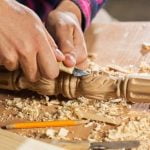Good woodwork is essential in a variety of applications, from construction to furniture making. Whether you are building a house or crafting a piece of furniture, the quality of the woodwork can make a significant difference in the end result. Understanding the importance of good woodwork and the key elements involved in this craft is crucial for anyone looking to delve into woodworking.
Woodworking involves working with different types of wood, using various tools and equipment, and mastering a range of techniques. Each aspect plays a crucial role in achieving high-quality results. In this article, we will explore the significance of good woodwork and provide valuable insights into the types of wood commonly used, essential tools and equipment, various techniques employed, and the benefits of utilizing good woodwork in construction and furniture making.
By delving into these topics, readers will gain a comprehensive understanding of what good woodwork entails and how it significantly impacts the outcome of their projects. Additionally, we will also discuss common mistakes to avoid for beginners in woodworking, showcase inspirational woodwork projects for motivation, and offer tips and advice for those new to this craft. Whether you are an experienced woodworking enthusiast or just starting out in this field, there is something valuable for everyone in this article.
Types of Wood
When it comes to good woodwork, choosing the right type of wood is crucial. Different types of wood offer unique qualities that make them suitable for various woodworking projects. One of the most popular types of wood used in woodworking is oak.
Oak is known for its strength, durability, and attractive grain pattern, making it ideal for furniture making, cabinetry, and flooring. Another commonly used wood is maple, which is prized for its light color and smooth texture, making it perfect for carving and turning.
Another popular choice for woodworking is cherry wood. Cherry is known for its rich color and beautiful grain pattern, making it a favorite for high-end furniture and decorative pieces. Pine is also widely used in woodworking due to its affordability and versatility. Its light color and soft texture make it great for a wide range of indoor projects such as shelves, cabinets, and trim work.
High-End Furniture, Decorative Pieces
It’s important to consider the characteristics of each type of wood when selecting materials for a woodworking project to ensure the best results. Understanding the qualities of different woods will not only help in achieving good woodwork but also lead to better overall craftsmanship.
Tools and Equipment
Woodworking requires a wide range of tools and equipment to achieve good results. Some of the essential tools include saws, chisels, planes, routers, drills, and sanders. Each tool serves a specific purpose in the woodworking process, from shaping and cutting wood to joining pieces together. It’s important to invest in high-quality tools that can withstand the demands of woodworking and deliver precise results.
In addition to hand tools, power tools also play a crucial role in woodworking. Power saws, such as table saws and miter saws, make cutting wood more efficient and accurate. Meanwhile, power drills and sanders help speed up the process of drilling holes and smoothing surfaces. These power tools are essential for larger projects or when working with harder woods that require more force to shape.
Furthermore, safety equipment is a non-negotiable aspect of woodworking. Protective gear such as goggles, gloves, and ear protection should be worn at all times to prevent injury from flying wood chips or loud machinery. Additionally, dust masks are necessary when sanding or working with materials that produce fine particles.
Prioritizing safety while using tools and equipment is crucial for any woodworker, regardless of their skill level. Selecting the appropriate tools and equipment for each project and wearing suitable safety gear ensures that the work is completed safely and effectively.is good woodwork.
Techniques
Woodworking involves a variety of techniques that are essential for creating high-quality, durable, and visually appealing woodwork. Whether it’s carving intricate designs, joining pieces together seamlessly, or applying the perfect finish, mastering these techniques is crucial for producing exceptional woodwork.
Carving
Carving is the process of shaping and removing material from wood to create intricate designs and patterns. It requires precision, skill, and the right tools to achieve detailed and professional-looking results. Good woodwork often incorporates beautiful carvings that add a unique touch to furniture, cabinetry, and decorative items.
Joinery
Joinery is the art of connecting wooden components together to form sturdy and functional structures. Common joinery techniques include dovetail joints, mortise and tenon joints, and finger joints. Achieving strong and seamless connections through joinery is essential for ensuring the durability and longevity of woodwork such as cabinets, tables, chairs, and door frames.
Finishing
The finishing touches on woodwork can truly elevate its overall appearance and appeal. Finishing techniques such as staining, varnishing, lacquering, or painting not only protect the wood but also enhance its natural beauty. A well-executed finish can bring out the grain patterns of the wood while providing a smooth and polished surface.
Mastering these techniques
Benefits of Good Woodwork
Good woodwork is essential in various applications, including construction and furniture making. Using high-quality woodworking techniques and materials can result in durable, visually appealing, and functional products. Whether it’s a sturdy table or a beautifully carved cabinet, good woodwork can significantly enhance the quality and longevity of the finished piece.
One of the primary benefits of good woodwork is durability. High-quality woodworking involves using strong and reliable types of wood, as well as precise techniques that ensure the structural integrity of the finished product. This means that furniture and structures made with good woodwork are less likely to break or deteriorate over time.
In addition to durability, good woodwork also contributes to the aesthetic appeal of the end product. Properly finished and polished wood surfaces can enhance the visual appeal of furniture and other wooden products. The use of different woodworking techniques such as carving, joinery, and finishing can result in unique and intricate designs that add value to the final piece.
| Benefit | Description |
|---|---|
| Durability | Furniture made with good woodwork is less likely to break or deteriorate over time. |
| Aesthetic Appeal | Properly finished and polished wood surfaces enhance the visual appeal of furniture. |
Common Mistakes to Avoid
When starting out in woodworking, it is important to be aware of some common mistakes that beginners often make. By understanding and avoiding these mistakes, you can improve your woodwork skills and produce better quality projects.
Choosing the Wrong Wood
One of the most common mistakes beginners make is choosing the wrong type of wood for their project. Different types of wood have different characteristics and are suitable for different purposes. For example, softwoods like pine are great for construction projects, while hardwoods like oak or maple are ideal for furniture making. Understanding the properties of each type of wood and selecting the right one for your project is crucial for good woodwork.
Ignoring Safety Precautions
Another mistake that beginners often make is ignoring safety precautions. Woodworking involves working with sharp tools and heavy machinery, so it is important to prioritize safety at all times. Using safety goggles, ear protection, and a dust mask, as well as following proper procedures when using power tools, will help prevent accidents and injuries.
Rushing Through the Process
Many beginners tend to rush through the woodworking process, which can lead to sloppy workmanship and mistakes. Taking your time to measure accurately, plan your cuts, and pay attention to detail is essential for good woodwork. Patience is key in woodworking, so take your time and focus on each step of the process to achieve high-quality results.
By being mindful of these common mistakes and taking steps to avoid them,is good woodwork attainable even for beginners in woodworking.
Inspirational Woodwork Projects
Woodworking is not only a practical skill but also an art form that allows for creativity and innovation. To inspire and motivate readers, here are some inspirational woodwork projects that showcase the beauty and versatility of good woodwork.
Some examples of impressive woodwork projects include:
- Hand-carved wooden sculptures: These intricate pieces showcase the skill and precision required for carving detailed designs out of wood.
- Custom furniture pieces: From elegant dining tables to unique chairs and benches, custom furniture projects demonstrate the endless possibilities of good woodwork in creating functional yet aesthetically pleasing pieces.
- Wooden jewelry and accessories: Delicate wooden jewelry, such as earrings, necklaces, and bracelets, highlight the finer details achievable through woodworking.
These inspirational woodwork projects serve as a reminder of the creativity and craftsmanship that is possible with good woodwork. Whether it’s a functional piece of furniture or a decorative item, these projects demonstrate the beauty and durability of well-crafted woodwork.
In addition to showcasing the creative potential of woodworking, these inspirational projects also serve as a source of motivation for those new to the craft. By observing the skills and techniques used in these projects, beginners can gain insight into the level of craftsmanship achievable with dedication and practice. Whether it’s mastering joinery techniques or refining finishing skills, these projects provide valuable inspiration for aspiring woodworkers.
Tips for Beginners
Woodworking can be a fulfilling and rewarding hobby or profession, but it’s important for beginners to start on the right foot. Here are some tips and advice for those new to woodworking:
- Start with the right tools: Invest in a good set of basic woodworking tools such as a saw, chisel, hammer, tape measure, and square. Having the right tools is essential for good woodwork.
- Safety first: Always prioritize safety when undertaking any woodworking project. This includes wearing protective gear like goggles and gloves, knowing how to properly handle tools, and keeping the workspace clean and organized.
- Practice makes perfect: Don’t be discouraged by mistakes – they are part of the learning process. Start with simple beginner-friendly projects such as a small shelf or picture frame before moving on to more complex pieces.
In addition to these tips, it’s important for beginners to remember that using the appropriate type of wood is crucial for good woodwork. Some common types of wood used in woodworking include:
- Pine: Often used for construction due to its affordability and ease of cutting.
- Oak: Known for its strength and durability, oak is commonly used in furniture making.
- Maple: This hardwood is favored for its fine grain and resistance to splitting, making it suitable for cabinetry and flooring.
By starting with the right tools, prioritizing safety, practicing regularly, and using high-quality wood, beginners can lay a strong foundation for their woodworking journey. Remember that patience is key – good woodwork takes time and dedication.
Conclusion
In conclusion, good woodwork is essential in various applications, whether it’s for construction, furniture making, or artistic purposes. Selecting the right type of wood is crucial, as different woods have unique characteristics that make them suitable for specific projects. With the right tools and equipment, along with mastering various techniques such as carving, joinery, and finishing, achieving good woodwork becomes more attainable.
The benefits of good woodwork are numerous, from durability and aesthetic appeal to environmental sustainability. By using high-quality woodworking in construction and furniture making, the end result is not only visually appealing but also long-lasting. However, beginners should be mindful of common mistakes to avoid to ensure a successful woodworking journey.
For those seeking inspiration and motivation, there are countless woodwork projects that showcase the beauty and versatility of good woodwork. Additionally, beginners can benefit from helpful tips and advice to get started on their woodworking journey successfully. Adhering to safety precautions and starting with beginner-friendly projects are important considerations for those new to woodworking.
In summary, good woodwork plays a significant role in various applications. Whether it’s selecting the right type of wood, using the proper tools and equipment, mastering woodworking techniques, or avoiding common mistakes, there are many aspects to consider when striving for quality results in woodworking. Ultimately, by prioritizing good woodwork practices and being mindful of key points discussed in this article ERSON’S NAME>, beginners can embark on a rewarding woodworking journey.
Frequently Asked Questions
Why Do People Woodwork?
People woodwork for a variety of reasons. For some, it’s a way to express their creativity and craftsmanship, creating unique and bespoke items from wood.
For others, it’s a practical skill that allows them to build or repair furniture and other items around the house. Additionally, woodworking can be a relaxing and meditative hobby, providing a break from the fast-paced digital world.
Is Woodworking Good for Your Brain?
Woodworking has been found to have numerous cognitive benefits. It requires problem-solving skills, spatial reasoning, and attention to detail, all of which can help improve brain function. Additionally, working with wood can improve hand-eye coordination and fine motor skills. Overall, engaging in woodworking activities can provide mental stimulation and contribute to overall cognitive health.
Why Is Woodshop Good?
Woodshop serves as an important space for learning and practical skill development. It provides an opportunity for students to gain hands-on experience with tools and materials while learning about design principles and construction techniques.
Woodshop also fosters creativity and allows students to bring their ideas to life through practical application, helping them develop confidence in their abilities. Beyond the specific skills learned, woodshop provides valuable lessons in patience, perseverance, and problem-solving.

Hi everyone! I’m a woodworker and blogger, and this is my woodworking blog. In my blog, I share tips and tricks for woodworkers of all skill levels, as well as project ideas that you can try yourself.





